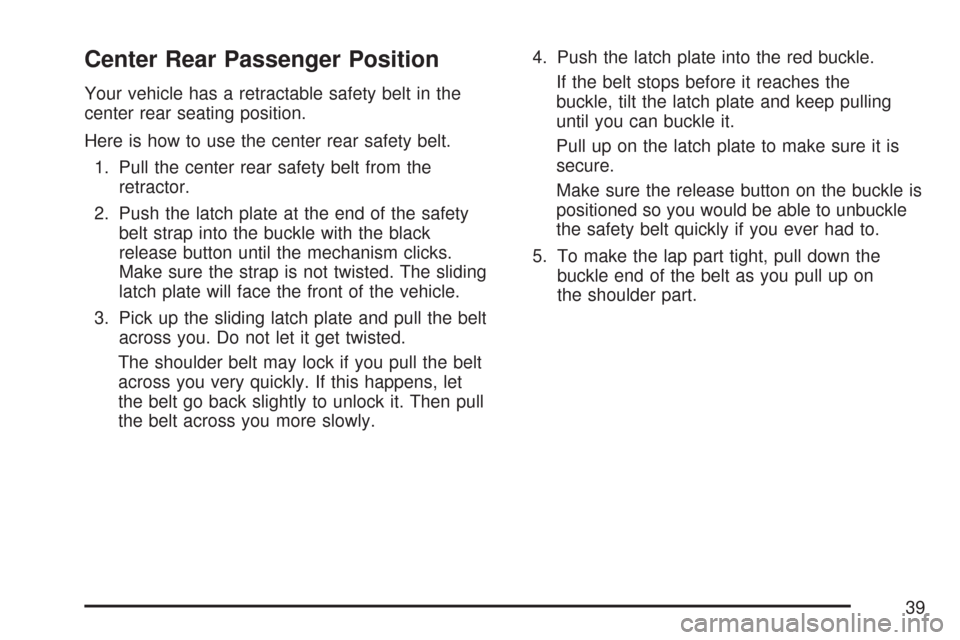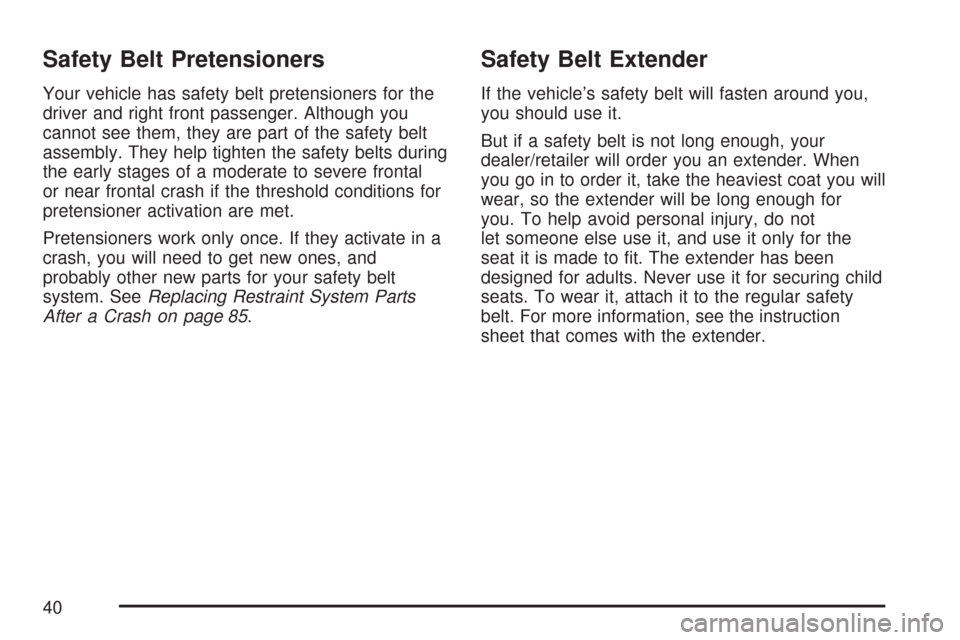Page 36 of 436
If the belt stops before it reaches the buckle,
tilt the latch plate and keep pulling until
you can buckle it.
Pull up on the latch plate to make sure it is
secure.
Make sure the release button on the buckle is
positioned so you would be able to unbuckle
the safety belt quickly if you ever had to.3. To make the lap part tight, pull down on the
buckle end of the belt as you pull up on the
shoulder part.
36
Page 37 of 436
The lap part of the belt should be worn low and
snug on the hips, just touching the thighs. In
a crash this applies force to the strong pelvic
bones. And you would be less likely to slide under
the lap belt. If you slid under it, the belt would
apply force at your abdomen. This could cause
serious or even fatal injuries. The shoulder
belt should go over the shoulder and across the
chest. These parts of the body are best able
to take belt restraining forces.
37
Page 38 of 436
The safety belt locks if there is a sudden stop or a
crash, or if you pull the belt very quickly out of
the retractor.
{CAUTION:
You can be seriously hurt if your shoulder
belt is too loose. In a crash, you would
move forward too much, which could
increase injury. The shoulder belt should
�t against your body.
To unlatch the belt, just push the button on the
buckle.
38
Page 39 of 436

Center Rear Passenger Position
Your vehicle has a retractable safety belt in the
center rear seating position.
Here is how to use the center rear safety belt.
1. Pull the center rear safety belt from the
retractor.
2. Push the latch plate at the end of the safety
belt strap into the buckle with the black
release button until the mechanism clicks.
Make sure the strap is not twisted. The sliding
latch plate will face the front of the vehicle.
3. Pick up the sliding latch plate and pull the belt
across you. Do not let it get twisted.
The shoulder belt may lock if you pull the belt
across you very quickly. If this happens, let
the belt go back slightly to unlock it. Then pull
the belt across you more slowly.4. Push the latch plate into the red buckle.
If the belt stops before it reaches the
buckle, tilt the latch plate and keep pulling
until you can buckle it.
Pull up on the latch plate to make sure it is
secure.
Make sure the release button on the buckle is
positioned so you would be able to unbuckle
the safety belt quickly if you ever had to.
5. To make the lap part tight, pull down the
buckle end of the belt as you pull up on
the shoulder part.
39
Page 40 of 436

Safety Belt Pretensioners
Your vehicle has safety belt pretensioners for the
driver and right front passenger. Although you
cannot see them, they are part of the safety belt
assembly. They help tighten the safety belts during
the early stages of a moderate to severe frontal
or near frontal crash if the threshold conditions for
pretensioner activation are met.
Pretensioners work only once. If they activate in a
crash, you will need to get new ones, and
probably other new parts for your safety belt
system. SeeReplacing Restraint System Parts
After a Crash on page 85.
Safety Belt Extender
If the vehicle’s safety belt will fasten around you,
you should use it.
But if a safety belt is not long enough, your
dealer/retailer will order you an extender. When
you go in to order it, take the heaviest coat you will
wear, so the extender will be long enough for
you. To help avoid personal injury, do not
let someone else use it, and use it only for the
seat it is made to fit. The extender has been
designed for adults. Never use it for securing child
seats. To wear it, attach it to the regular safety
belt. For more information, see the instruction
sheet that comes with the extender.
40
Page 41 of 436
Child Restraints
Older Children
Older children who have outgrown booster seats
should wear the vehicle’s safety belts.
Q:What is the proper way to wear safety
belts?
A:If possible, an older child should wear a
lap-shoulder belt and get the additional
restraint a shoulder belt can provide. The
shoulder belt should not cross the face
or neck. The lap belt should fit snugly below
the hips, just touching the top of the thighs. It
should never be worn over the abdomen,
which could cause severe or even fatal internal
injuries in a crash.
According to accident statistics, children are safer
when properly restrained in the rear seating
positions than in the front seating positions.
In a crash, children who are not buckled up can
strike other people who are buckled up, or can be
thrown out of the vehicle. Older children need
to use safety belts properly.
41
Page 42 of 436
{CAUTION:
Never do this.
Here two children are wearing the same
belt. The belt cannot properly spread the
impact forces. In a crash, the two children
can be crushed together and seriously
injured. A belt must be used by only one
person at a time.
Q:What if a child is wearing a lap-shoulder
belt, but the child is so small that the
shoulder belt is very close to the child’s
face or neck?
A:If the child is sitting in a seat next to a
window, move the child toward the center of
the vehicle. If the child is sitting in the
center rear seat passenger position, move the
child toward the safety belt buckle. In either
case, be sure that the shoulder belt still
is on the child’s shoulder, so that in a crash
the child’s upper body would have the restraint
that belts provide.
42
Page 43 of 436
{CAUTION:
Never do this.
Here a child is sitting in a seat that has a
lap-shoulder belt, but the shoulder part is
behind the child. If the child wears the
belt in this way, in a crash the child might
slide under the belt. The belt’s force
would then be applied right on the child’s
abdomen. That could cause serious or
fatal injuries.
Wherever the child sits, the lap portion of the belt
should be worn low and snug on the hips, just
touching the child’s thighs. This applies belt force
to the child’s pelvic bones in a crash.
43